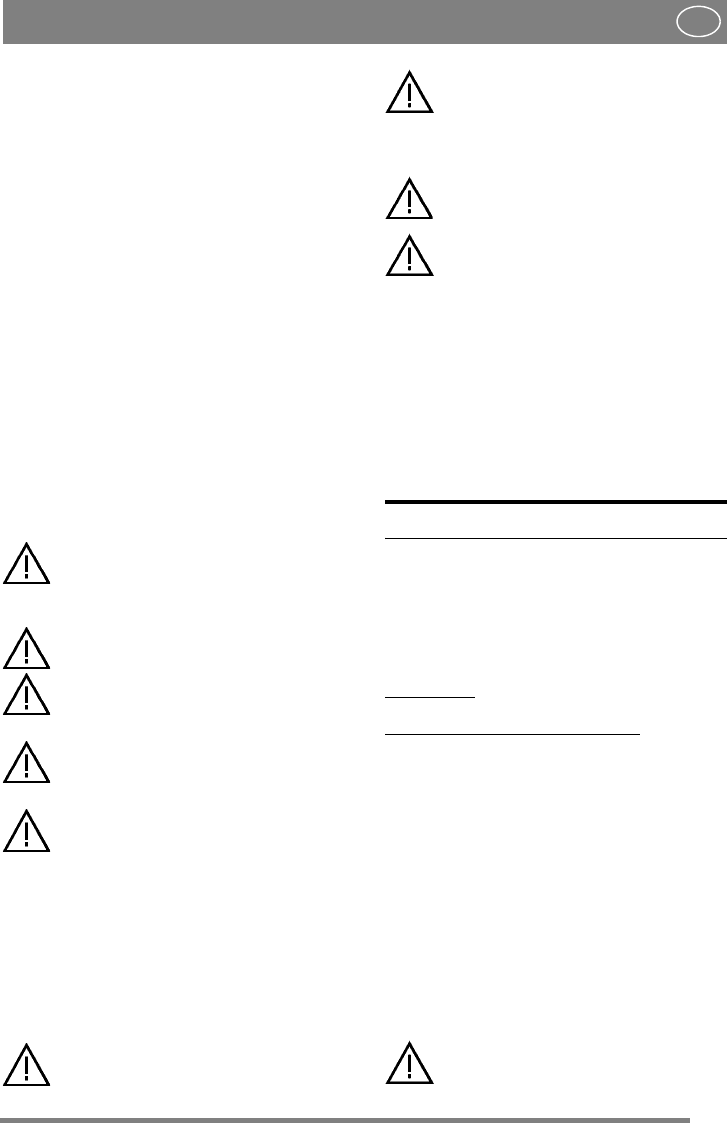
29
ENGLISH
EN
13.5 Start
1. Open the fuel cock. See 16.
2. Check that the spark plug cable(s) is/are in-
stalled on the spark plug(s).
3. Check to make sure that the power take-off is
disengaged.
4. Do not keep your foot on the drive pedal.
5. Put the throttle control at full throttle.
Starting cold engine – pull the choke control out
fully.
Starting warm engine – the choke control
should be pressed in.
6. Depress the clutch-brake pedal fully.
7. Turn the ignition key and start the engine.
8 Once the engine has started, push the choke
control in gradually if it has been used.
9. When starting from cold, do not make the ma-
chine work under load immediately, but let the
engine run for a few minutes first. This will al-
low the oil to warm up.
When the machine is in operation, full throttle
should always be used.
13.6 Operating tips
Always check that there is the correct volume of
oil in the engine. This is particularly important
when operating on slopes. See “13.2”.
Be careful when driving on slopes. No
sudden starting or stopping when driv-
ing up or down a slope. Never drive
across a slope. Move from the top down
or from the bottom to the top.
The machine may not be driven on
slopes greater than 10º in any direction.
Reduce the speed on slopes and when
making sharp turns in order to retain
control and reduce the risk of tipping
over.
Do not turn the steering wheel to full
lock when driving in top gear and at full
throttle. The machine can easily topple
over.
Keep hands and fingers well away from
articulated steering joint and seat
bracket. Risk of crushing injuries. Nev-
er drive with the engine casing open.
13.7 Stop
Disengage the power take-off. Apply the parking
brake.
Allow the engine to idle 1-2 mins. Stop the engine
by turning off the ignition key.
Shut off the petrol cock. This is particularly impor-
tant if the machine is to be transported on a trailer
for example.
If the machine is left unattended, re-
move the spark plug cable(s) and re-
move the ignition key.
The engine may be very warm immedi-
ately after it is shut off. Do not touch the
silencer, cylinder or cooling fins. This
can cause burn injuries.
13.8 Cleaning
To reduce the risk of fire, keep the en-
gine, silencer, battery and fuel tank free
from grass, leaves and oil.
To reduce the risk of fire, regularly
check the machine for oil and/or fuel
leakage.
Clean the machine after each use. The following
instructions apply for cleaning:
• When washing the machine with water under
high pressure, do not point the jet directly at
axle seals, electrical components or hydraulic
valves.
• Do not spray water directly at the engine.
• Clean the engine with a brush and/or com-
pressed air.
• Clean the engine’s cooling air intake (14:W).
14 MAINTENANCE
14.1Service programme
In order to keep the machine in good condition as
regards reliability and operational safety as well as
from an environmental perspective, STIGA’s Ser-
vice programme should be followed.
The contents of this programme can be found in
the attached service log.
Basic service
must always be carried out by an au-
thorised workshop.
First service and intermediate service
should be
carried out by an authorised workshop, but can
also be carried out by the user. The content of this
can be found in the service log and the actions are
described under “13.4” as well as below.
Servicing carried out at an authorised workshop
guarantees professional work using genuine spare
parts.
At each basic service and intermediate service car-
ried out at an authorised workshop, the service log
is stamped. A service log presenting these services
is a valuable document that improves the ma-
chine’s second-hand value.
14.2 Preparation
All service and all maintenance must be carried out
on a stationary machine with the engine switched
off.
Prevent the machine from rolling by al-
ways applying the parking brake.


















